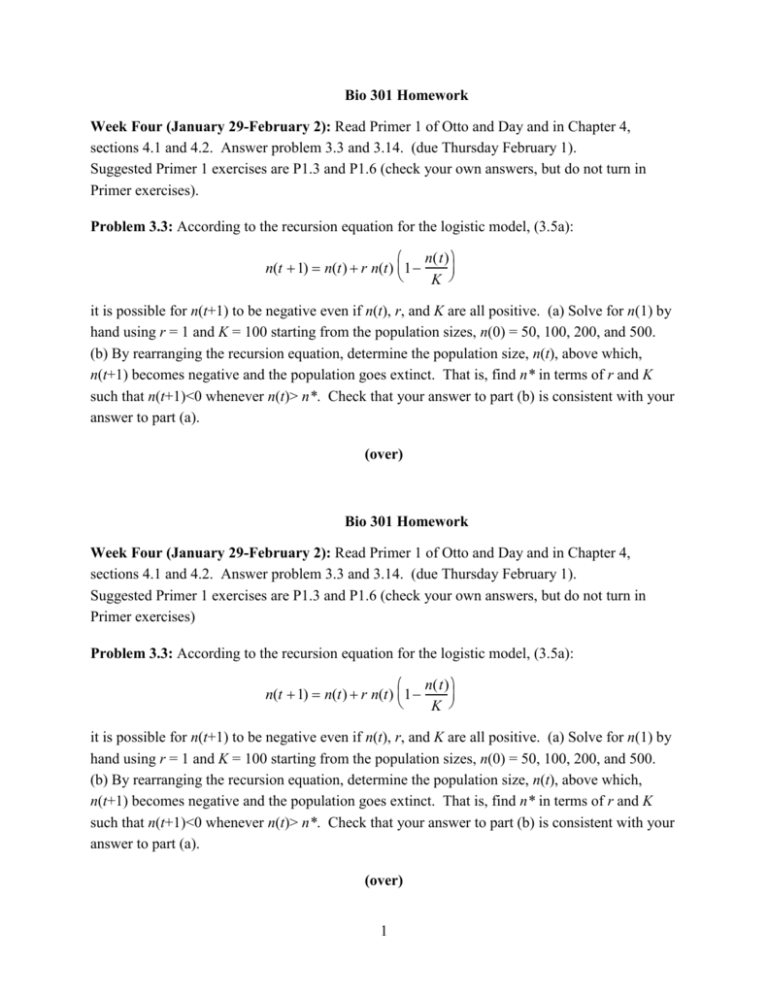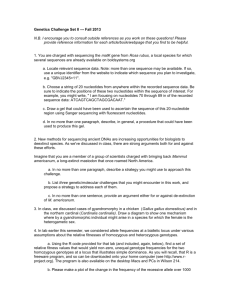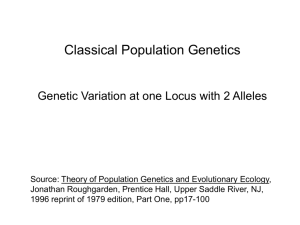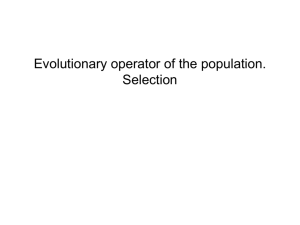Homework3
advertisement

Bio 301 Homework Week Four (January 29-February 2): Read Primer 1 of Otto and Day and in Chapter 4, sections 4.1 and 4.2. Answer problem 3.3 and 3.14. (due Thursday February 1). Suggested Primer 1 exercises are P1.3 and P1.6 (check your own answers, but do not turn in Primer exercises). Problem 3.3: According to the recursion equation for the logistic model, (3.5a): n(t) n(t 1) n(t) r n(t) 1 K it is possible for n(t+1) to be negative even if n(t), r, and K are all positive. (a) Solve for n(1) by hand using r = 1 and K = 100 starting from the population sizes, n(0) = 50, 100, 200, and 500. (b) By rearranging the recursion equation, determine the population size, n(t), above which, n(t+1) becomes negative and the population goes extinct. That is, find n* in terms of r and K such that n(t+1)<0 whenever n(t)> n*. Check that your answer to part (b) is consistent with your answer to part (a). (over) Bio 301 Homework Week Four (January 29-February 2): Read Primer 1 of Otto and Day and in Chapter 4, sections 4.1 and 4.2. Answer problem 3.3 and 3.14. (due Thursday February 1). Suggested Primer 1 exercises are P1.3 and P1.6 (check your own answers, but do not turn in Primer exercises) Problem 3.3: According to the recursion equation for the logistic model, (3.5a): n(t) n(t 1) n(t) r n(t) 1 K it is possible for n(t+1) to be negative even if n(t), r, and K are all positive. (a) Solve for n(1) by hand using r = 1 and K = 100 starting from the population sizes, n(0) = 50, 100, 200, and 500. (b) By rearranging the recursion equation, determine the population size, n(t), above which, n(t+1) becomes negative and the population goes extinct. That is, find n* in terms of r and K such that n(t+1)<0 whenever n(t)> n*. Check that your answer to part (b) is consistent with your answer to part (a). (over) 1 Problem 3.14: Mating within a population is often not random. If a population is spatially structured or if kin prefer to mate with one another, then gametes carrying the same genes unite more often than one would expect under random mating. This is because the parents are related to one another and therefore are likely to carry the same genes, a phenomenon known as inbreeding. The simplest way to account for inbreeding in population-genetics models is to say that each egg has a chance, 1 – f, of being fertilized by a sperm drawn randomly from the gamete pool and a chance, f, of being fertilized by a sperm carrying the same allele. Convince yourself that the probability of producing an AA zygote will then equal (1 – f) p(t)2 + f p(t) . (a) Calculate the probability of producing an Aa zygote and an aa zygote. Using these results, modify the second through fourths columns of Table 3.2, making sure that the second column sums to one and that the fourth column sums to one. (b) Based on this modified table, derive the recursion equation for p(t+1), generalizing (3.13a) to the case of non-random mating. (c) Using this recursion, prove that the allele frequency does not change over time if the genotypes are equally fit (WAA = WAa = Waa = 1). Problem 3.14: Mating within a population is often not random. If a population is spatially structured or if kin prefer to mate with one another, then gametes carrying the same genes unite more often than one would expect under random mating. This is because the parents are related to one another and therefore are likely to carry the same genes, a phenomenon known as inbreeding. The simplest way to account for inbreeding in population-genetics models is to say that each egg has a chance, 1 – f, of being fertilized by a sperm drawn randomly from the gamete pool and a chance, f, of being fertilized by a sperm carrying the same allele. Convince yourself that the probability of producing an AA zygote will then equal (1 – f) p(t)2 + f p(t) . (a) Calculate the probability of producing an Aa zygote and an aa zygote. Using these results, modify the second through fourths columns of Table 3.2, making sure that the second column sums to one and that the fourth column sums to one. (b) Based on this modified table, derive the recursion equation for p(t+1), generalizing (3.13a) to the case of non-random mating. (c) Using this recursion, prove that the allele frequency does not change over time if the genotypes are equally fit (WAA = WAa = Waa = 1). 2









